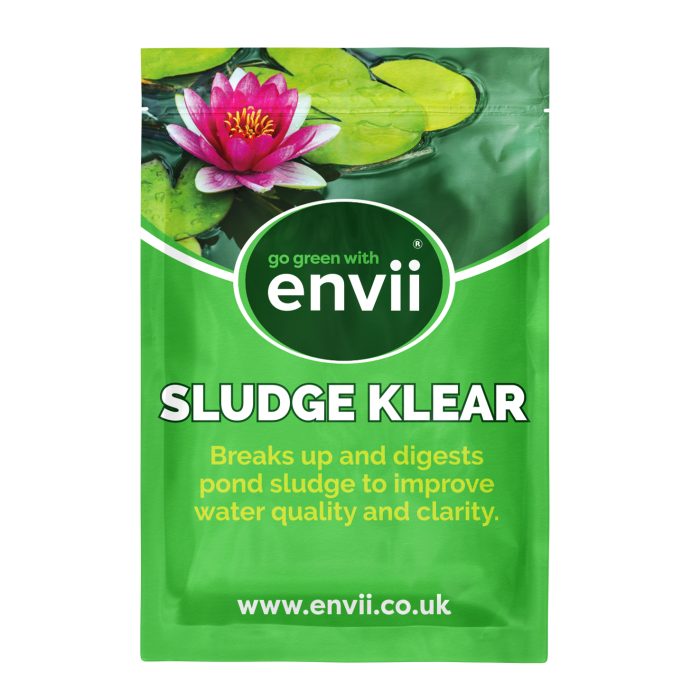Sludge is a common problem for pond owners and unfortunately, it’s inevitable. When found in traces and small quantities, it’s not too much of a problem. However, problems can begin when your pond contains a build up of sludge. We’re talking about the thick, gunky stuff that sits as a layer at the bottom of the pond and has an odour.
While it is a common problem, pond keepers don’t always understand what pond sludge is and how it occurs. Along with the issues caused by leaving it untreated and what pond keepers can do to keep it under control. Read on to discover what sludge is and how you can remove it…
What Is Pond Sludge?
Pond sludge is made up of the organic materials that are found in and around your pond. Ranging from fish food, faeces and plant debris, it is the end product of when all of this matter falls to the bottom of your pond and begins to rot.
At first, this process may be barely noticeable when you have little to no debris in your pond, however as time goes on and more matter breaks down, the sludge becomes thicker and therefore impenetrable to oxygen. The sludge eventually takes up an anaerobic state that causes the bacteria within the pond to produce Hydrogen Sulphide.
As many of you will know, Hydrogen Sulphide smells like rotten eggs (you may have come across this smell after disturbing the bottom of your pond or cleaning out your filters).

Hydrogen Sulphide is toxic. Due to its nature of interfering with the oxygenation and respiration of aquatic life in ponds. This begins with how Hydrogen Sulphide kills off aerobic bacteria which are typically responsible for breaking down organic matter and algae.
Pond sludge, in essence, contributes to the occurrence of algae blooms as there aren’t sufficient amounts of beneficial aerobic bacteria in the pond to break down and keep up with the rate of algae growth.
The lack of bacteria will then lead to your pond plants and fish suffering, deteriorating and eventually dying. As more and more of your pond life dies it adds to your layer of pond sludge and creates a vicious cycle.

How Do I Prevent Pond Sludge?
Remember the saying “prevention is always better can cure”? Well the same principle applies with sludge. Preventing or at least, minimising the amount of sludge is easy enough to do and will keep your pond running efficiently.
Always be sure to remove any floating debris as and when you see it. Take care when cutting your lawn as lawn cuttings can easily find their way into the pond and quickly sink to the bottom.
Finally, use aquatic cloth liners or aquatic gravel in submerged plants to keep the fish from digging them up. Koi especially, find digging up plants very amusing!

How to Remove Pond Sludge
Sludge is inevitable in some ponds, despite having taken all the preventative measures to stop it. At this point, you have two options to treat the pond.
Physically remove
You can either physically remove the sludge using your hands or a pond vacuum. These will get rid of the physical matter but will remove some of the helpful, aerobic bacteria and leave behind some of the harmful Hydrogen Sulphide.

Beneficial Bacteria
The second thing is to add extra, beneficial bacteria into the pond to “attack” the sludge, break it down and digest it whilst topping up the aerobic bacteria in your pond.
Envii Sludge Klear contains a unique blend of bacteria and enzymes that break down and digest the pond sludge. Sludge Klear can be used as a treatment product and maintenance product to keep your bacteria levels high and sludge levels low all year round.

Need more context? Watch our Complete Guide to Pond Sludge here:
Featured products

Envii Sludge Klear
Reduces sludge in ponds and clears murky water.
£14.99 View Product
Envii Pond Klear & Sludge Klear
Clears green water and reduces sludge from ponds.
£26.99 View Product

 Call us on 01246 240880
Call us on 01246 240880 Sign-up and receive 10% off
Sign-up and receive 10% off


I have the same problem in my pond with newts. 1.7 x 1 metre. Been plagued by constant slimey algae for last 2 years pond is over 13 years old never had a problem. Should I sludge treat before trying any further algae treatment? Barley straw and pond dye hasn’t worked
My pond has very deep sludge. The pond is only for natural creatures such as Newts and frogs. To date the creatures seem to prosper in the pond however the sludge is almost taking over. What can I safely use not to kill the wildlife in order to get rid of the sludge